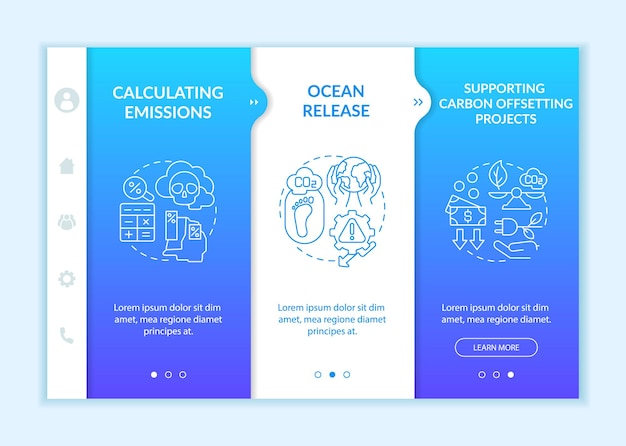
Image Source: FreeImages
In today's digital age, having a strong online presence is crucial for businesses. Websites serve as a gateway for customers to access information, products, and services.
However, the energy consumption and carbon emissions associated with website development and hosting have a significant environmental impact.
As the world becomes more conscious of climate change, it is essential for web designers and businesses to take steps to reduce their carbon footprint.
Understanding the Environmental Impact of Web Design and offsetting your carbon footprint
The process of creating and maintaining a website involves various elements that contribute to its carbon footprint. These include the energy required to power servers and data centers, the transmission of data over networks, and the production and disposal of electronic devices.
Research has shown that the IT industry's carbon emissions are comparable to those of the aviation industry, responsible for approximately 2-4% of global greenhouse gas emissions[^2^].
As more people access the internet and generate data, these emissions are predicted to increase.
The Role of Hosting Providers in Carbon Offset
One of the most critical factors in reducing the carbon footprint of a website is the choice of hosting provider.
Hosting companies are responsible for powering the servers and data centers that store and deliver websites.
Opting for a hosting provider with a commitment to environmentally friendly practices is essential in minimizing the environmental impact of web design.
Green Credentials and Renewable Energy
When selecting a hosting provider, it is crucial to examine their green credentials and energy policy.
Look for providers that prioritize renewable energy sources and have implemented energy-efficient technologies in their data centers.
Many hosting companies now emphasize their green initiatives and disclose information about the percentage of renewable energy they use or the carbon offset programs they participate in.
It is essential to verify that hosting providers take concrete steps to minimize their environmental impact.
Carbon Offset Programs
While some hosting providers may still rely partially on non-renewable energy sources, they can compensate for their carbon emissions through carbon offset programs.
These programs involve investing in projects that reduce greenhouse gas emissions or promote environmental conservation.
By participating in carbon offset programs, hosting providers can become carbon neutral or even carbon negative, effectively mitigating the environmental impact of their operations.
The Role of Content Delivery Networks (CDNs)
Content Delivery Networks (CDNs) play a crucial role in reducing the carbon footprint of websites. CDNs distribute content across a network of servers located in different geographical areas.
By delivering content from servers that are closest to the end users, CDNs reduce the distance data needs to travel, resulting in lower energy consumption and carbon emissions.
Additionally, CDNs can utilize energy-efficient servers, further reducing their environmental impact.
Optimizing Website Energy Consumption
In addition to selecting an environmentally friendly hosting provider, web designers can take steps to optimize the energy consumption of websites.
By implementing sustainable design practices, websites can reduce their carbon footprint while improving user experience and performance.
Web Page Optimization
Establishing a web page budget at the beginning of the design process can guide designers in creating sustainable websites.
This budget sets targets for carbon reduction and encourages the optimization of content and files.
Designers should choose efficient image formats, such as SVG, WEBP, or AVIF, that reduce file sizes and energy consumption.
Minimizing the use of custom web fonts and opting for system fonts or open-source alternatives also contributes to energy efficiency.
Additionally, designers should question the necessity of videos and images, ensuring that they serve a purpose and are optimized for size and format.
Clean and Efficient Code
Keeping the code clean and simple is crucial in reducing energy consumption.
Using efficient and straightforward coding languages, such as HTML and CSS, minimizes the need for energy-intensive programming languages.
Furthermore, reducing the use of web analytics tools and gathering only essential data helps minimize page weight and energy consumption.
By regularly reviewing and optimizing website content, designers can ensure that every element serves a purpose and contributes to energy efficiency.
Search Engine Optimization (SEO)
Implementing effective SEO practices not only improves website visibility but also reduces unnecessary browsing and carbon emissions.
By optimizing website content and structure, designers can help users find the information they need quickly, reducing the time spent navigating through multiple pages.
This optimization also aligns with the goal of providing a better user experience, leading to increased conversion rates and customer satisfaction.
Carbon Offset and Sustainability in Web Design
To achieve carbon neutrality and build sustainable websites, designers and businesses can go beyond optimizing energy consumption.
Carbon offsetting plays a crucial role in mitigating the remaining carbon emissions associated with web design and hosting.
Purchasing Carbon Offset Credits
Carbon offset credits are sold by certified organizations that invest in projects aimed at reducing greenhouse gas emissions.
By purchasing these credits, web designers and businesses can compensate for the carbon emissions produced by their websites.
These projects may include initiatives such as reforestation, renewable energy, or waste management.
Some hosting providers even participate in carbon offset programs, offsetting their carbon emissions twice over or more.
The Role of Trees in Carbon Offsetting
Planting trees is an effective way to offset carbon emissions. Trees absorb carbon dioxide as they grow, effectively sequestering carbon and reducing greenhouse gas levels.
Many organizations, including wearegeeky.com, actively promote tree planting as part of their carbon offsetting efforts.
By integrating tree planting initiatives into web design and development, designers can contribute to a more sustainable and carbon-neutral future.
Continuous Monitoring and Improvement
Achieving carbon neutrality is an ongoing process that requires continuous monitoring and improvement.
Web designers and businesses should regularly measure their website's carbon footprint and seek opportunities for further sustainability.
Tools such as website carbon calculators and analytics can provide insights into energy consumption and carbon emissions.
By staying informed about the latest developments in sustainable web design, designers can adapt their practices and contribute to a greener internet.
Conclusion
In an era of increasing environmental awareness, reducing the carbon footprint of websites is essential. Web designers and businesses have a responsibility to prioritize sustainability in web design and hosting.
By selecting environmentally friendly hosting providers, optimizing energy consumption, and participating in carbon offset programs, web designers can build sustainable websites that minimize their environmental impact.
With continuous monitoring and improvement, the goal of carbon neutrality in web design can be achieved, contributing to a greener and more sustainable future.
Additional Information: At wearegeeky.com, we are committed to reducing our carbon footprint and promoting sustainable practices.
As part of our efforts, we plant trees to offset our carbon emissions and prioritize environmentally friendly hosting providers.
We are dedicated to creating unique and innovative web designs that not only meet our clients' needs but also contribute to a healthier planet.
Join us in building a greener internet through sustainable web design practices.
What are the benefits of off setting your carbon footprint?
Offsetting your carbon footprint can have numerous benefits, both for the environment and for you personally. In a world where climate change is becoming an increasingly pressing issue, taking steps to reduce and offset your carbon emissions is crucial.
Let's explore some of the advantages of offsetting your carbon footprint.
First and foremost, offsetting your carbon footprint helps to combat climate change. By investing in projects that reduce or remove greenhouse gas emissions, you are effectively neutralizing the environmental impact of your own activities.
These projects can range from renewable energy initiatives to reforestation efforts, which not only reduce carbon emissions but also help to restore ecosystems and preserve biodiversity.
Another benefit of offsetting your carbon footprint is that it allows you to take responsibility for your own environmental impact. By actively seeking ways to mitigate your carbon emissions, you are demonstrating your commitment to reducing your ecological footprint.
This can be a powerful personal statement and can inspire others to do the same.
Offsetting your carbon footprint can also contribute to the development of sustainable communities and economies.
Many offset projects focus on supporting local communities by providing job opportunities and promoting sustainable practices. This can help create a more equitable and resilient society, while also fostering innovation in renewable energy and other green technologies.
Additionally, offsetting your carbon footprint can enhance your company's reputation and brand image. In today's socially conscious world, consumers are increasingly drawn to businesses that demonstrate their commitment to sustainability.
By offsetting your carbon emissions, you can differentiate yourself from competitors and attract environmentally conscious customers.
Furthermore, offsetting your carbon footprint can have financial benefits. In some regions, governments offer tax incentives or subsidies for companies and individuals who invest in carbon offset projects.
This can help offset the cost of implementing sustainable practices and make it more financially viable for businesses to transition to a greener model.
Lastly, offsetting your carbon footprint provides a sense of personal satisfaction and fulfillment. Knowing that you are actively contributing to the fight against climate change can bring a sense of purpose and pride.
It is empowering to know that even as an individual, you have the ability to make a positive impact on the world.
In conclusion, offsetting your carbon footprint offers a range of benefits, from combating climate change and promoting sustainable development to enhancing your personal and professional reputation.
It is a powerful way to take responsibility for your own environmental impact and contribute to a more sustainable future for all. So why wait? Start offsetting your carbon emissions today and be part of the solution!

